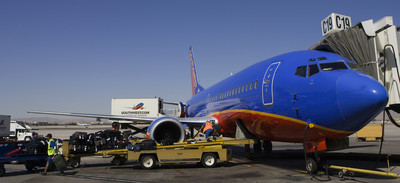Southwest’s focus: Arrive on time


Other than “Is there a pilot on board?” the phrase, “Attention passengers, your flight is delayed,” may be the six worst words in air travel.
Unfortunately for the flying public, 2007 has been the worst year for flight delays since the government started keeping track of late planes in 1995.
Among major airlines, however, Southwest Airlines is among the best performers when it comes to delivering people on time, with more than 80 percent of flights landing within 15 minutes of scheduled arrival. The industrywide rate was 73 percent.
Factors such as bad weather and air traffic control glitches are among the many contributors to late flights that airlines can’t control.
Bill Owen, Southwest’s lead schedule planner, was in Las Vegas recently for a conference and took time out to talk about what the airlines do control when it comes to making air travel efficient.
“People focus on what makes things late,” said Owen, who was in Las Vegas for a conference on blogging that the airline sponsored. “Let’s focus on what makes things on time.”
Owen said work on scheduling flights starts months, even years, before a passenger buys a ticket.
He broke schedule planning into three segments: strategic, capacity planning and schedule operations.
The strategic portion is most removed from daily travel and includes thinking about what the airline will need in five to 10 years and making decisions about long-term goals, Owen said.
Capacity planning happens 18 to 24 months in advance and includes decisions aimed at matching the placement of airlines with market demand.
The most immediate planning comes weeks or months before a flight takes off. That includes making seasonal schedules that account for holidays, events, the potential for foul weather and predictable changes in wind patterns.
“Winter winds are typically stronger; we have to be looking ahead and figuring these things out,” Owen said.
To account for the factors that can make flights late, airlines tweak variables that impact two different periods of time — block time and turn time.
Block time is the time from when an airport leaves a departure gate and pulls into an arrival gate. Turn time is the amount of time it takes to ready an arriving plane for another departure.
The airline wants to make block time and turn time as short as possible to maximize the amount of flights it can operate during a day.
Owen said customers don’t like to leave before 6:30 a.m. or after 9 p.m. and they don’t like arriving after midnight.
“That means you have a constrained operating day,” he said. “You have to be very careful and surgical in how you are operating that time.”
Southwest uses software to consolidate any savings in block time or turn time and allocate it throughout its network that includes about 3,300 daily flights with nearly 500 737 aircraft.
For example, the software helps planners convert block time savings when soft summer winds make east to west flights shorter into extra flights. It used the savings to produce additional routes between Las Vegas and Sacramento, Calif., San Jose, Calif., and Albuquerque, N.M., in addition to adding an extra eight hours and 45 minutes of recovery time every day from March through October.
Reality, however, has a way of disrupting even the best laid plans.
In February, a day after the NBA All Star Game, thousands of Southwest passengers leaving Las Vegas overwhelmed the airline’s ticket agents. The airline couldn’t process them fast enough, leading to a line of an estimated 2,000 or more passengers stretching outside the airport on a windy, rainy day.
Owen attributed the Monday backup to passengers arriving late for early flights around the same time others were showing up on time for midmorning flights. It took the airline until midday Tuesday to catch up.
“Had we known in advance how heavy that day was, probably what we should have done was space those flights out a little more and made sure we had more time,” he said.
As for things going smoothly, Owen attributed much of Southwest’s on-time performance to its high percentage of point-to-point flights and general assignment boarding procedure.
But those factors are changing. Airline consultant Michael Boyd estimated as many as 50 percent of Southwest flights are connecting or multistop affairs. And the airline is tweaking its general admission seating to provide more structure.
“They know they have a product that is becoming less competitive,” Boyd said.
He added, however, that the changes won’t slow down traffic and should improve the airline.
“Southwest is evolving,” he said. “They are very good now, they are going to be a whole lot better a year from now.”
Contact reporter Benjamin Spillman at bspillman@reviewjournal.com or (702) 477-3861.












